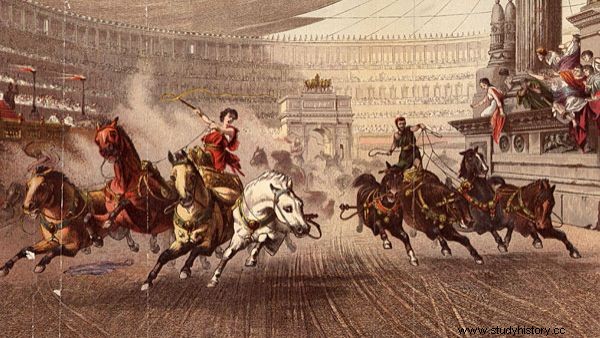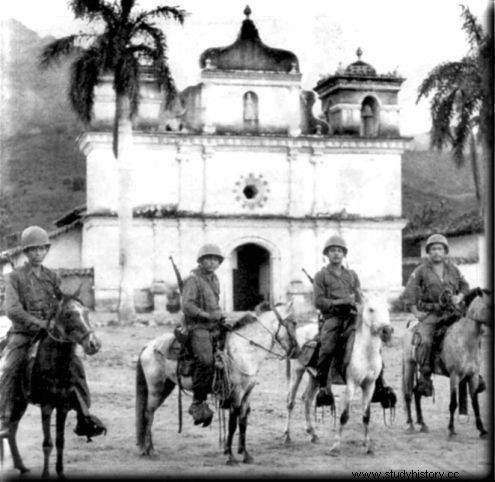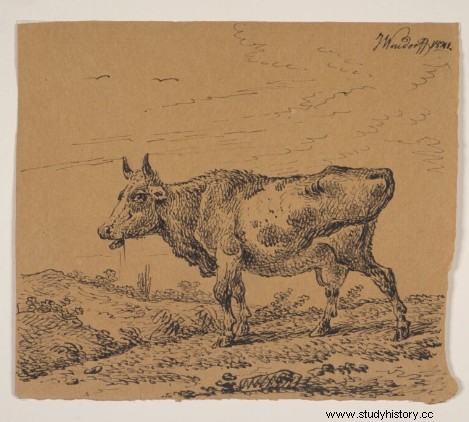The screams of the fighters, the groans of the dying, the clash of arms and the fight to the last drop of blood, but for what? It turns out that people could fight for the proverbial golden underpants. Offended pride, neighborly aversion, the so-called scythe with another club - this is the second face of the history of strange wars, among which the one really so-called from 1939 seems quite normal.
Anyone who would seek the causes of wars only in political antagonisms between states would be wrong. It turns out that the sports competition was an equally good contribution to the bloodshed. In January 532, the capital of Byzantium, Constantinople, became the scene of bloody riots due to ... the chariot race.
Kibolskie gangs?
Groups of fans of this discipline organized themselves into real gangs, which even tried to influence the election of the ruler. Two groups, the Green and the Blue (named after the club colors), gained a special position. There have always been fights between them, but this time the emperor himself added fuel to the fire. He sentenced several members of both clubs to death for murders committed during earlier brawls at the hippodrome . Therefore, the opposing fans joined forces and during the next races, loudly insulting the ruler, they went to his palace. An agitated crowd, shouting: nika, nika (advance or conquer), besieged the seat of Justinian I for five days, plundering the city at the same time.

Constantinople has become the scene of bloody riots because of… the chariot race. Illustrative photo.
It even got to the point that the rebellious factions announced the election of a new emperor - Hypatius, and Justinian was ready to abdicate. In the end, at the urging of his wife, he managed to bribe the representatives of the Blue party, reminding him that he himself was their supporter, while Hypatius supported the Greens. At the time of the coronation of the "kibolski" emperor, the Heavenly people left the hippodrome. The imperial troops attacked the crowd of the Greens left there, committing a real slaughter - around 30,000 people died .
It turns out that sport was not only able to arouse such bloody passions in antiquity. This time football has become a stone of contention. The so-called football war (or the 100 Hours War) was a five-day conflict between El Salvador and Honduras. In fact, the tension in relations between the two countries had been going on before, one of the main reasons being the settlement of Salvadoran farmers on the Honduran borderlands. In this situation, Honduras' defeat in the qualifying match of the World Cup in June 1969 turned out to be a kind of an excuse to even the scores. In the face of hostile actions by Honduras on the border, on July 14, the Salvadoran army attacked its neighbor and only under pressure from the Organization of American States did the hostilities stop. The war claimed about 3,000 dead, and El Salvador, despite being promoted to the World Cup, was finally eliminated from the tournament in the group stage . However, the peace treaty was not signed until 10 years later.

The football war cost about 2,000 lives. people
Battle for… oak bucket
The enthusiasm for the leather object of desire can still be explained somehow, but what can be said about ... an oak bucket? The decisive battle between Modena and Bologna at Zappolino in November 1325 had its excuse in stealing a wooden kit. In the fourteenth century, northern Italy was divided into many principalities and city-states that were often in great conflict. Modena and Bologna were also mutual antagonists. The boiling point between cities reached its apogee as Modena troops stormed downtown Bologna and retrieved a bucket from the city's main well. Faced with such an affront and the refusal to return the precious artifact Bologna's 32,000 army moved to Modena . Despite the fact that it had much smaller forces (about 7,000), it managed to defeat the invaders and kept its prey. Legend has it that Modena took another bucket as a war trophy.
Cow's War
The bucket as inanimate matter did not care for being in the center of the fighters' attention. What could a cow think of something like that? The story of a certain dwarf began in the winter of 1468, when a farmer near Świdwin in Brandenburg handed over his cow to a good neighbor from the Pomeranian Białogard for a winter. When it was time to hand over the animal in the spring, it turned out that the Białogard man did not intend to fulfill the contract. When the pleas and pleas did not help, the Pomeranian-German antagonisms still alive in these areas were voiced . The victim organized a neighborhood support group, which successfully restored the cow in question overnight. This did not end the matter, as the host from Białogard, in turn, felt humiliated and together with his squad seized the heroine of our story along with several companions.

One of the more absurd conflicts was the battle for the cow
Therefore, the inhabitants of Świdwin complained to their landwójt Jakob von Polenz, who forwarded the complaint to Karsten von Wopersnow (the owner of the castle in Białogard). The latter, however, did not want to hear anything and threw the accusers out of the castle. The landowner of Świdwin, dismissed with a receipt, decided to settle the matter differently. On his order, the stolen croissants were to be returned to their rightful owners. There were many volunteers to carry out this order. Of course all cows are black at night and it was hard to know which of them might have been stolen . So they were chased one by one, requisitioning more of them than was necessary. Such mutual approaches could not last forever and the ruler of Białogard decided to attack his neighbors. The general clash took place on July 15, 1469, in the moors near the village of Cysznewo. The townspeople, knights, peasants and the castle servants fought side by side in the three-hour battle . The zealous von Wopersnow most likely escaped at the beginning of the battle, in which about 300 Białogardians were killed and 100 were taken prisoner of Świdwin. In addition, the winners' banner of the defeated and 50 weapons cars were looted.
The prisoners were taken to the town tower in Świdwin, where they were to wait for the payment of the ransom. This one, however, never influenced and the unfortunates finished their days without seeing their Białogard anymore. On the other hand, the bodies of the fallen were left on the moor to the prey of the wild game, and their remains were seen there for many years to come.
Unaware of its importance, the cow was not the only animal in history to become the source of war or a cause for battle. Dogs, pigs and ... the army of ostriches also claimed their place in history. But about this and other incredible reasons for the battles, which sometimes was not (!) Next time.
